With the NFL regular season underway, we welcome you back to another year of Detroit Lions film reviews. Each Tuesday, time permitting, we’ll review the tape from the previous weekend’s game, digging deeper into an important theme from the contest.
Following Sunday’s season-opening loss to the Philadelphia Eagles, we struggled to limit our focus to one area. So we’ll start with Detroit’s offense, which posted 35 points in the loss, before shifting to the defense’s struggles to contain Eagles quarterback Jalen Hurts.
Hot start
Let’s begin this review with Detroit’s nine-play touchdown drive to open the contest. And if we’re being honest, it wasn’t particularly pretty. The team had to overcome multiple problems on the series, including a negative play on the first snap, a dropped pass and back-to-back false starts by over-anxious guard Logan Stenberg, who was making his first start.
But the Lions were able to overcome each issue, thanks to some excellent run blocking and a good play call in the red zone.
Things really got going on the second play, when running back D’Andre Swift broke free for a 50-yard gain. Prior to the snap, tight end T.J. Hockenson was lined up off left tackle, with receiver Amon-Ra St. Brown in the slot on the strong side of the formation.
Both played critical roles in the play’s success, with Hockenson impressively sealing 305-pound defensive tackle Javon Hargrave inside and St. Brown digging out safety C.J. Gardner-Johnson, keeping Swift’s run lane clear. Additionally, center Frank Ragnow was able to climb to the second level and get just enough of linebacker Kyzir White, leaving Swift one-on-one with cornerback James Bradberry, whom Swift beat with a little shoulder shimmy before angling toward the sideline for the long gain.
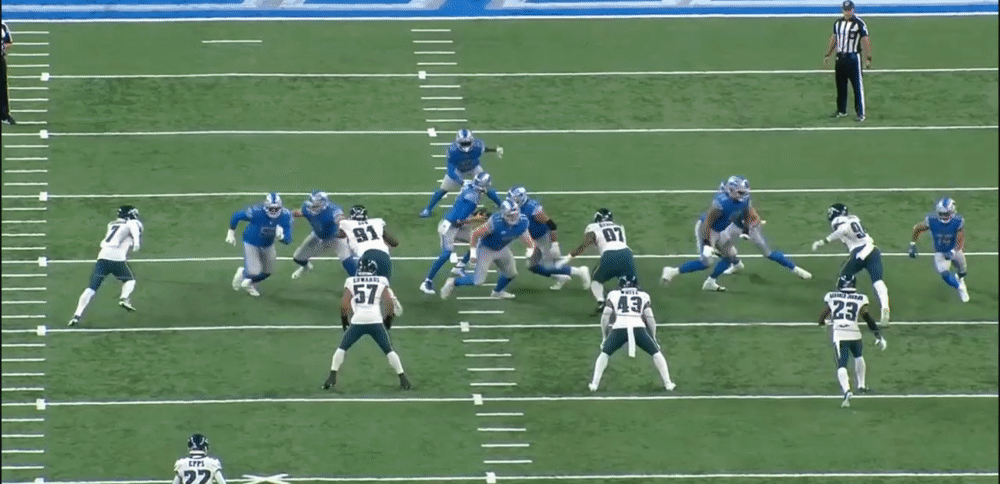
Detroit kept things on the ground from there, with back-to-back runs by Jamaal Williams, netting another first down. On the first carry, Detroit’s front executed a trio of combo blocks with Ragnow and guard Jonah Jackson smoothly breaking off to the second level and bodying the Eagles linebackers, resulting in a 7-yard gain.
And on the second, Hockenson had another good block, pulling across the formation, allowing Williams to squeeze out enough for the first down.
Following DJ Chark’s ugly drop on the next play and Stenberg’s two flags, the Lions faced 2nd-and-20. Fortunately, a handoff to Swift gained the penalty yardage back and made it 3rd-and-manageable.
Swift showed good vision on the shotgun run, reading the hat placement of Eagles defensive tackle Milton Williams before cutting sharply through a lane between the blocks of Ragnow and left tackle Taylor Decker. An underrated component of the play’s success was Jackson pulling right on the left-side run, funneling the attention of the Eagles linebackers in the opposite direction of the carry.
The Lions were able to convert the third down in the red zone with a quality play design. The left-side route combination had Hockenson running the trail route from a stack behind Josh Reynolds. The receiver ran vertically, ultimately creating a natural pick when he bumped into Gardner-Johnson, who was covering Hockenson. The defensive back’s momentary stumble provided the necessary separation for the tight end, who got the ball to the sticks after the catch to set up first-and-goal.

Williams capped the drive with two carries. He came up just short of the goal line on the first, thanks to more quality blocking from the receivers and tight ends. Hockenson, St. Brown and Reynolds all effectively sealed their assignments outside the run lane, contributing to the quality gain on first down.
The back gets all the credit for the touchdown, though. Jackson was supposed to serve as a lead blocker on a pull, but got tied up helping redirect a penetrating interior defender. That left two Eagles players unblocked to fill the run lane. Williams lowered his shoulder at the line and somehow managed to keep his balance before bouncing outside to finish the scoring run.
Midgame lull
After opening with the touchdown, the Lions went into a rut, failing to secure a first down the next four possession. Let’s take a look at what went wrong with each.
► First possession
Much like the game’s opening drive, the Lions started with a negative play. The design was simple: a quick throw to St. Brown in the slot with right tackle Penei Sewell firing out to the flat to provide an initial block. But credit goes to Eagles safety Marcus Epps, who made an incredible read from his pre-snap depth of 12 yards, firing downhill, beating Sewell to the spot and chopping down St. Brown just as the ball arrived.
Swift was able to gain 6 yards on a shotgun run on second down, picking up some quality blocks from the right side, as Sewell collapsed the edge and Hockenson sealed the outside of the run lane.
On third down, the Eagles brought heavy pressure, sending seven. Swift stepped up to pick up the blitzing Gardner-Johnson, but got knocked back into quarterback Jared Goff, who rushed an errant throw under heavy duress.
Watching it a few times, it wouldn’t be surprising to see the Lions situationally adjust the read progressions on the play design since the blitz opened the middle of the field, where Hockenson had a step on the defender while running a crossing route.
► Second possession
Going back to the ground to open the next series, the Lions telegraphed the direction of the first play with Hockenson and St. Brown condensed to the right and tight end Brock Wright motioning to that side pre-snap.
Despite having only six defenders in the box, the Eagles were effectively able to muddy the run lanes on the stretch-zone attempt, dropping Swift after a 1-yard gain.
Detroit kept the ball on the ground for second down, but despite a good hole at the line for Swift on the shotgun handoff, Wright’s inability to clear out linebacker T.J. Edwards in the second level led to the back being dropped after 2 yards.
Third down saw another Eagles blitz, which the Lions did a poor job identifying before the snap. That resulted in pressure from Goff’s right. Still, the QB was able to get off a quick throw. The problem ended up being Chark was on a different page with his option route, leading to an incompletion.
► Third possession
Things remained stuck in neutral the following series, when Goff misfired wide to a tightly covered Hockenson to open the possession, blowing the opportunity for a 6-yard pickup.
Second and third downs were even worse for the QB, who led a defender into the passing lane with his eyes on a throw to Hockenson, leading to a dangerous breakup across the middle of the field. And on third down, he threw into double coverage, nearly resulting in an interception.
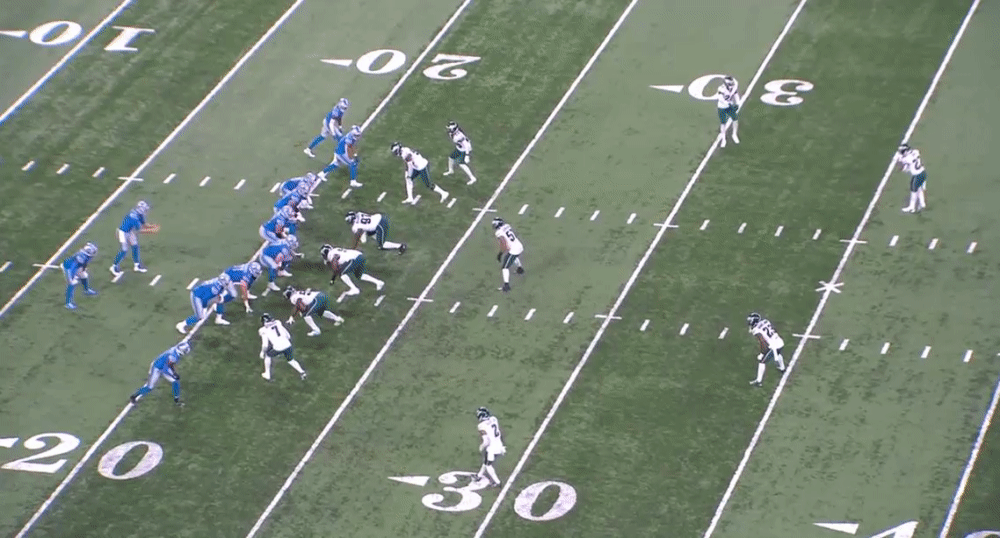
To make matters worse, all three throws came from a clean pocket.
► Fourth possession
The Lions went heavy on first down, bringing in offensive tackle Matt Nelson as a third tight end. With some decent push up front, Williams was able to gain 4 yards up the middle on first down.
But the situation quickly became muddied when Jackson fell and Stenberg lost his block, forcing Swift to bounce a second-down run outside. That ad-lib by the back put Hockenson in a tough spot, leading to a holding infraction.
Now facing 2nd-and-long, the Lions felt forced to throw and emptied the backfield, lining Swift out wide. That isn’t an inherently bad decision, but Stenberg was immediately beaten off the snap by defensive tackle Marlon Tuipulotu, pressuring Goff into a bad decision. That ball should have never been thrown, given the circumstances. Instead, it was intercepted by Bradberry and returned 27 yards for a touchdown.
► Conclusion
Detroit’s lull was largely the result of execution errors across the unit. The blocking had multiple breakdowns throughout the stretch, hindering the effectiveness of the ground game, while Goff struggled with his accuracy and decision-making.
Down-the-stretch recovery
Following the pick-six, the Lions’ offense found its footing and finished the game scoring touchdowns on four of the team’s final five possessions. Here’s what led to that success.
► First touchdown drive
Detroit’s downfield passing game finally showed up late in the first half. Facing the threat of going three-and-out again, the Lions lined up with trips to the left side on 3rd-and-5. The idea is to stress the Eagles’ zone, and it works with the underneath defender sticking with St. Brown on a sitdown route at the sticks, while Reynolds comes free on a corner route from the slot, netting a 28-yard gain.
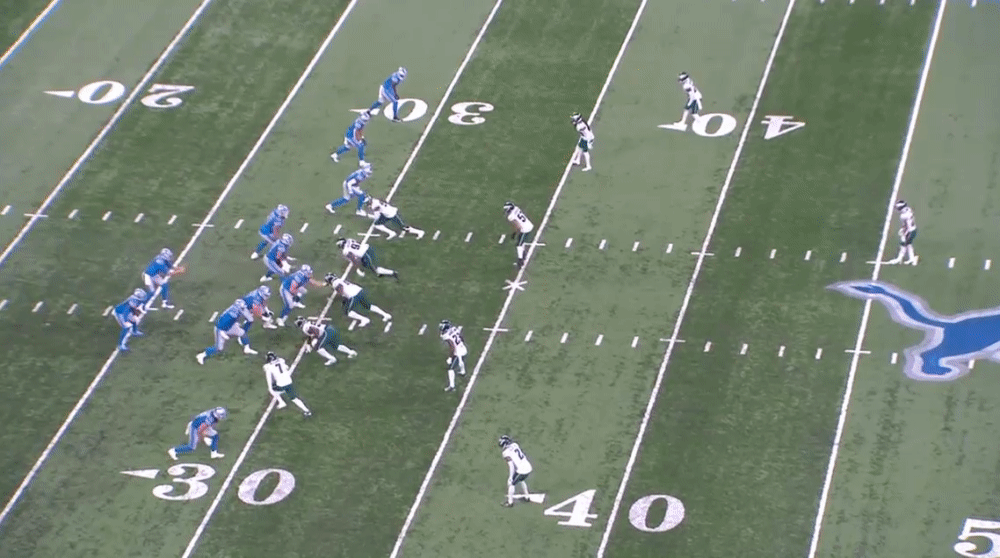
After a thwarted deep-shot attempt, thrown away after pressure from a nickel blitz, Swift scores a fresh set of downs with an impressive individual effort, making two interior cuts off his blocking to gain 13 yards.
Detroit then gets another 13-yard pickup on a well-designed route by St. Brown that sees the receiver sit down in the middle of the field out of a crossing pattern.
The Lions nearly scored two plays later on a pitch to Swift, who picked up strong blocks from Chark and Decker on the perimeter, but Jackson’s cut block on the linebacker in the second level was ineffective, allowing the Eagles to make the stop a yard short of a first down.
Swift cashed in two plays later, on 4th-and-1, again running left. From an offset alignment, he utilized a well-executed cut block by Wright and a crack block by Chark to get the edge, then followed the pulling Jackson, who bulldozed the lone defensive back in position to make the stop.
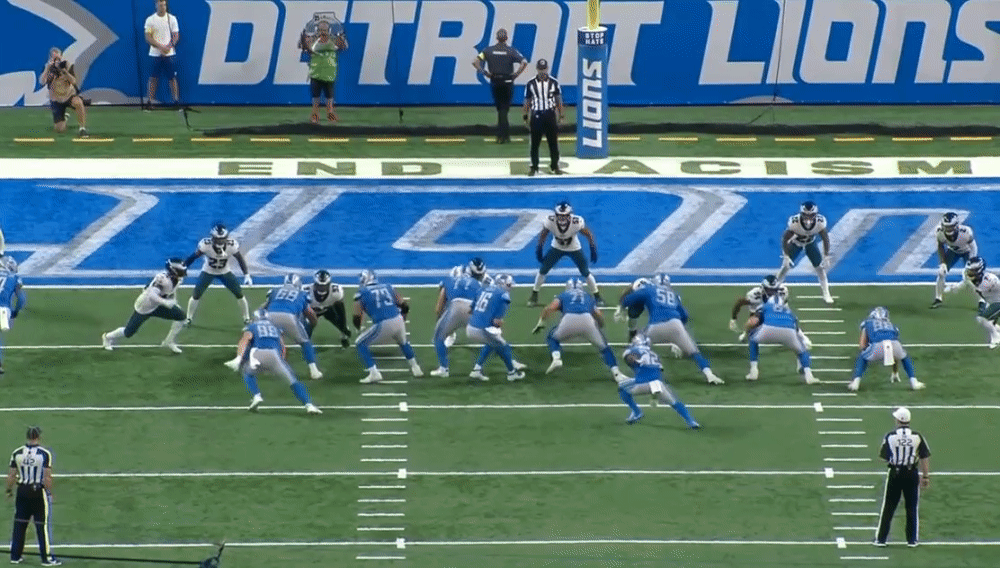
► Second touchdown drive
What an ugly, inefficient drive that isn’t conducive to sustainable success, even if you welcome the end result.
The Lions found themselves in trouble immediately after Hockenson blew a block on second down, resulting in a 2-yard loss for Williams that set up 3rd-and-10. But Swift came to the rescue once again, taking a draw, utilizing a strong second-level block from Jackson and outrunning the safety to the perimeter for a 16-yard gain and a fresh set of downs.
Detroit unloaded another shot into their foot when Williams dropped a pass in the flat, but got bailed out when the Eagles jumped offside, creating a 3rd-and-manageable, where Goff fit a tight-window throw in to Chark for another conversion.
The momentum was nearly derailed by a terrible mistake from the quarterback, who sidestepped pressure in the pocket before unloading an errant throw downfield to Kalif Raymond that probably should have been intercepted.
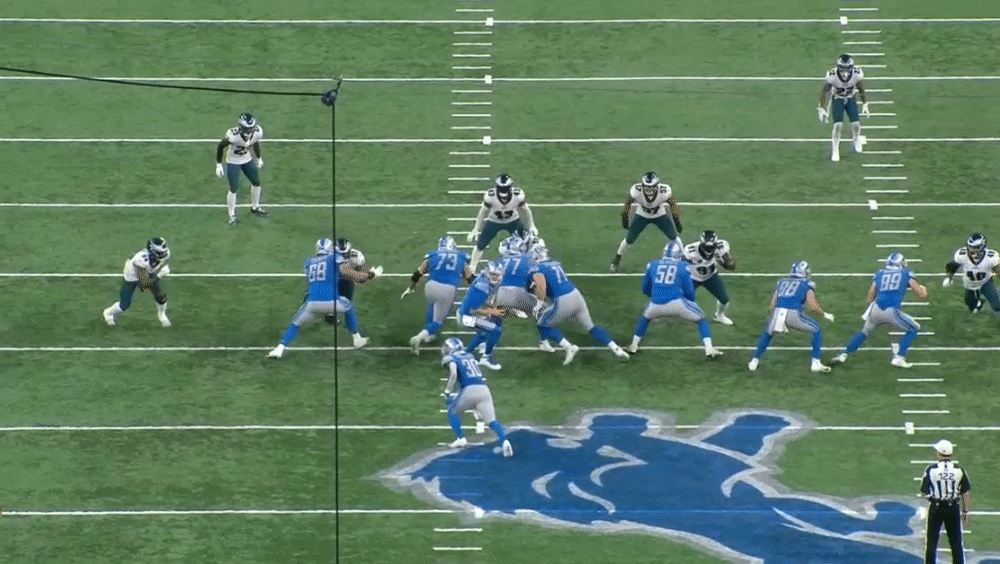
Detroit found new life on a well-designed screen to Hockenson, which saw Swift run a wheel route out of the backfield to the same side, creating additional room for the tight end to operate, leading to a 16-yard gain.
Another drop, this time from St. Brown, followed by another poor block by Hockenson limiting Swift’s run gain on second down, had the Lions facing another third-and-long. This time, pressure from the left side of the line forced the QB to scramble, but to Goff’s credit, he made the nickelback miss in the open field to get Detroit into the red zone.
After misfiring on a would-be touchdown to Reynolds, Goff connected with St. Brown for a score on third down. The receiver wasn’t the primary target, running into the left flat out of pre-snap motion, but when the initial reads were covered, he made a smart adjustment back to the middle of the field, where the QB found him just short of the goal line.
► Third touchdown drive
This was probably coordinator Ben Johnson’s best-called drive, kickstarted by a well-designed, zone-beating pass play. Stacked near the right hash ahead of the snap, Chark and St. Brown both ran vertically in the secondary. As the defense funneled its attention to Chark, St. Brown broke toward the sideline, where there was extra space with the underneath defender occupied by Swift in the flat. The pass to St. Brown netted 29 yards.
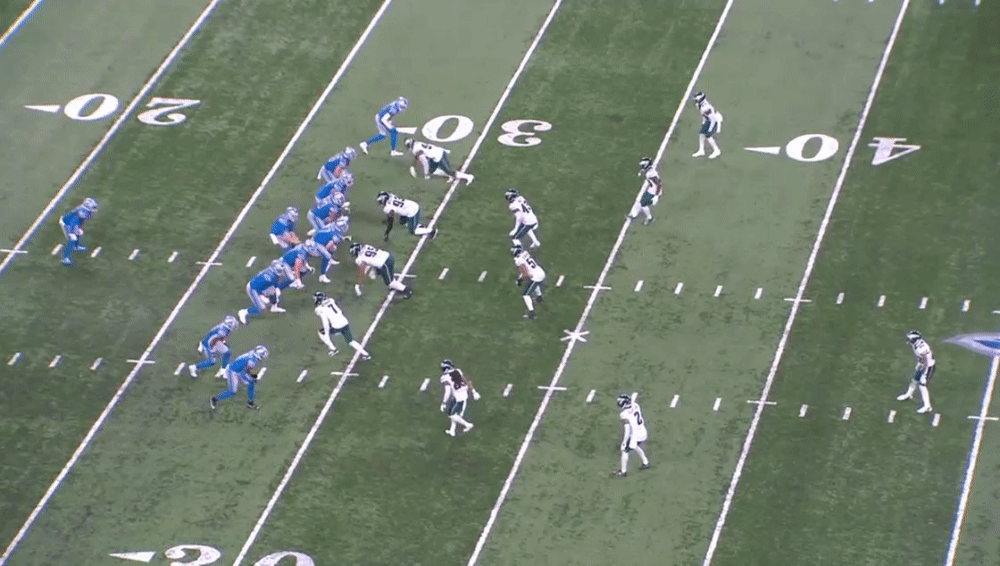
Following St. Brown’s dropping a would-be first down out of play-action, Hockenson made a difficult, diving grab across the middle on a ball outside his frame to give the Lions another first down.
Johnson followed that up by calling a screen to Swift out of play-action, which had Goff rolling away from the back before throwing back across the field. Swift was able to spin out of a tackle near the sideline, ultimately gaining 25 yards down to the 1-yard line, where Williams punched it in on the next snap.
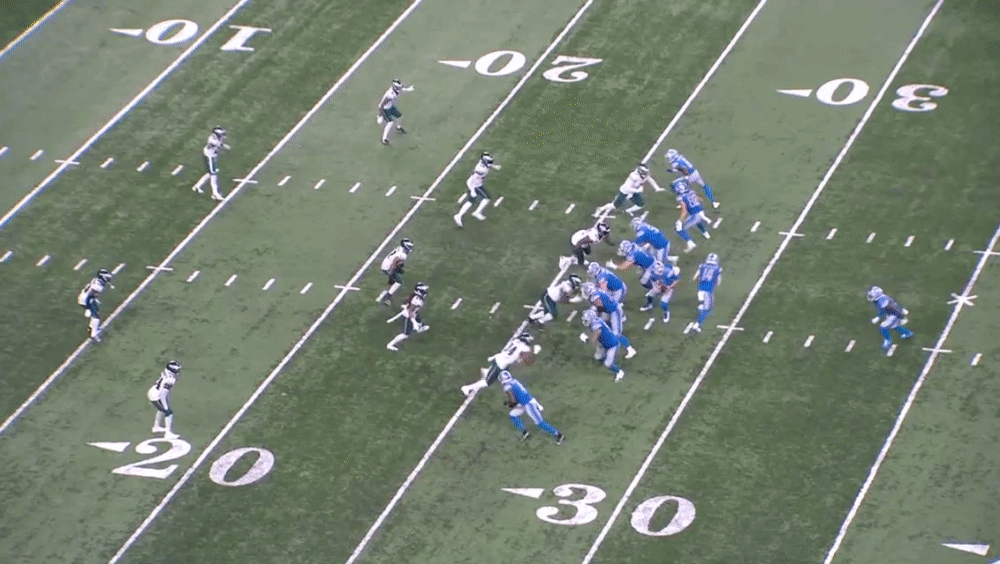
► Fourth touchdown drive
After punting on their previous possession, in large part due to Goff just missing Reynolds on a downfield throw and a botched snap resulting in a sack, the Lions got back on track with a third second-half touchdown on their final offensive series.
And again, it wasn’t pretty, but it got the job done, keeping a comeback effort in play.
With the run game sputtering, Detroit was left having to convert a trio of third downs to keep the drive afloat. They accomplished that with Chark shaking the nickel corner in traffic on a drag route, Swift beating a linebacker on a pattern to the right flat and T.J. Hockenson drawing a pass-interference call across the middle.
Goff was hit and miss during stretch, obviously connecting on the two third-down throws, but missing long on a deep ball to Chark and sailing another pass well over Raymond, who was open after shaking the defensive back while running a corner pattern.
Facing another 3rd-and-short from the 22-yard line, Goff delivered his best throw of the game, a perfectly-placed back-shoulder ball to Chark, who was well-covered by cornerback Darius Slay. The pair were isolated near the right sideline and Chark was able to create late separation to complete the scoring grab, drawing the Lions within three with 4:28 remaining.

► Conclusion
It was a productive finish, but the Lions were still plagued by far too many execution errors, often putting them in more difficult positions than necessary. Some of that was due to drops; other times it was subpar blocking, and the quarterback also had his share of struggles.
One of the clear positives was the effort to push the ball downfield, but Goff’s accuracy was unreliable most of the afternoon. While the Lions did a good job digging themselves out of holes against the Eagles, that’s not sustainable for long-term success.
Johnson did seem to settle into a rhythm as a play-caller. It’s unclear whether the concepts being utilized were part of the original game plan, or adjustments based on what the Eagles were showing defensively in the early stages of the contest, but several of the pass plays in particular were effective against Philadelphia’s coverage looks.
A pain defending Hurts
Most weeks, 35 points should be enough to win you a game. Not on this day as the defense gave up 31, paired with Goff’s pick-six, which put Detroit on the losing end.
While the offense hit that midgame lull, the Eagles caught fire through the second and third quarters, scoring on five of six possessions, including four touchdowns.
Philadelphia did much of its damage on the ground, racking up 216 yards on 39 carries, led by the problematic, dual-threat capabilities of Hurts, who accounted for 90 of those yards.
Hurts beat the Lions a multitude of ways, including a number of zone-reads, a few designed runs, as well as some unscripted scrambles. And just the threat of the quarterback running was enough to open up some other playmaking elements of the Eagles’ offense.
Since Hurts was the primary source of the defense’s frustrations, we thought it would be reasonable to evaluate how he beat the Lions with his feet before closing the book on this game.
Hurts’ running ability came into play immediately as he logged carries the Eagles’ first two offensive plays and had 35 yards at the end of that drive.
On the first snap, he hung on to a zone-read after both rookie defensive end Aidan Hutchinson and linebacker Derrick Barnes funneled to the running back on the play fake, leading to an 8-yard pickup. A play later, Hurts dropped back to pass, but when Alex Anzalone and Malcolm Rodriguez each tracked the running back to the flat, it left the second level clear for the quarterback to scramble for 11 more.
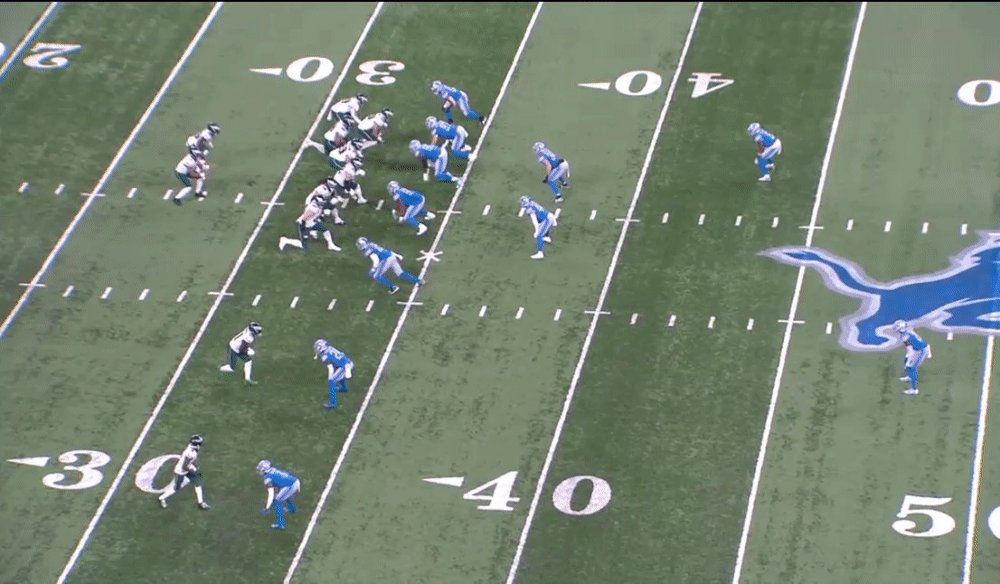
Both instances were prime examples of players either not fully knowing their responsibilities within the play or trying to do more than they were assigned, putting them out of position.
Later in the drive, on third-and-long, Hurts again broke free from the pocket for a 16-yard gain. In this instance, he took advantage of Charles Harris taking a wide rush angle beyond the quarterback’s depth in the pocket. Any good defensive coach will tell you that you can’t do this against a mobile threat, yet the issue cropped up multiple times, including Austin Bryant doing it on back-to-back plays late in the third quarter, during the Eagles’ final touchdown drive.
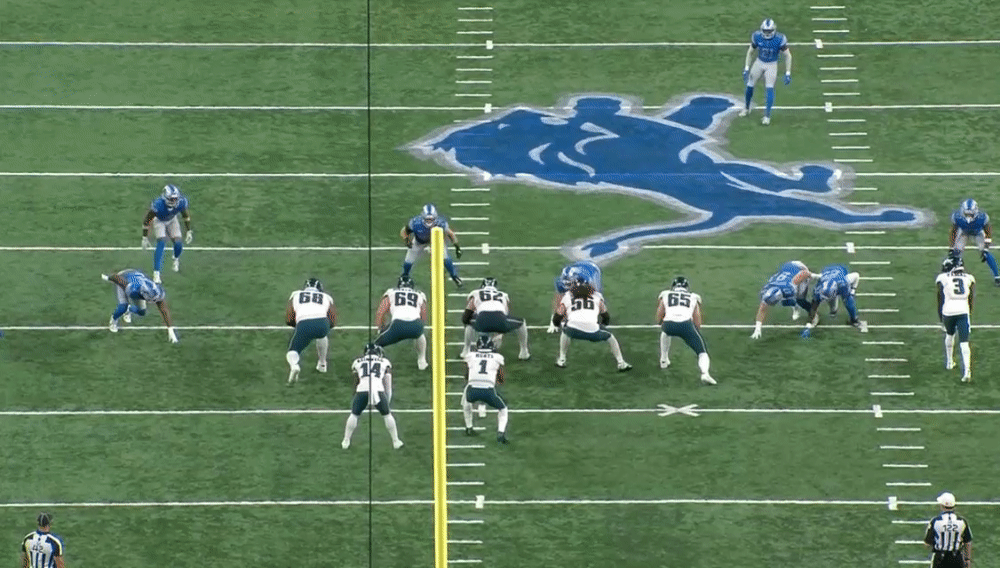
Detroit also had a number of issues maintaining their rush lanes. A prime example came in the first quarter, when the Lions brought in their “NASCAR” pass rush package on third down. While the defensive linemen maintained adequate positioning, Anzalone, supplementing the rush as a blitzer, was driven well outside of his gap responsibility, allowing Hurts to scramble up the middle for 10 yards and a first down.

And on Hurts’ touchdown run early in the second quarter, Barnes conceded the edge on a zone-read keeper, getting sucked too far inside while eyeing the play fake to the back.
Detroit’s zone-read defense did improve as the game progressed. Harris was frequently tasked as the read defender, and did good work staying wide and square to the line of scrimmage, forcing the completion of the handoff. The Lions also did more to offer a second layer of help with the linebackers or, occasionally, the nickel corner.
But as noted, even the threat of Hurts running eventually opened up other avenues for the Eagles to punish the Lions. A prime example was a delayed route to the flat by tight end Dallas Goedert, who went unchecked because nickelback Mike Hughes couldn’t take his eyes out of the backfield on the zone-read action.
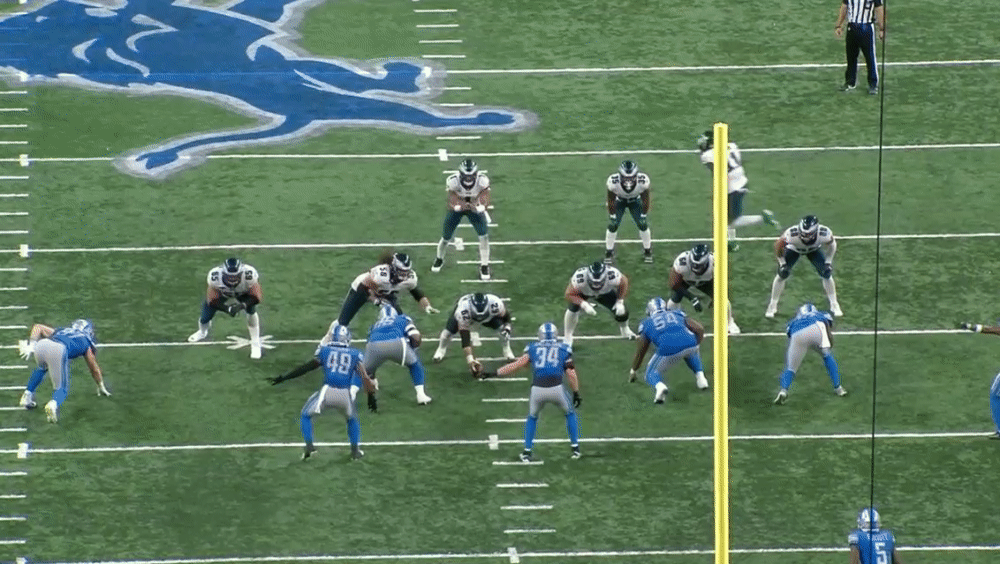
And frustrations clearly mounted for the Lions as Anzalone delivered a blatant and unnecessary hit to Hurts after a zone-read handoff, drawing a 15-yard flag. And a quarter later, safety Tracy Walker delivered a late hit to a sliding Hurts, drawing one flag, before earning an ejection for a second infraction during a post-whistle scuffle.
Still, as noted, there was progress. Hurts only had 33 yards rushing in the second half and the Eagles offense was forced into two quick punts during the fourth quarter, facilitating Detroit’s comeback effort.
Perhaps the best news for the Lions is they won’t see another quarterback with this level of dual-threat ability until Josh Allen and the Buffalo Bills come to town for a Thanksgiving matchup.
jdrogers@detroitnews.com
Twitter: @Justin_Rogers